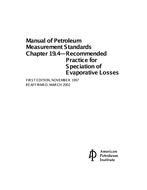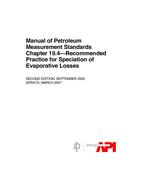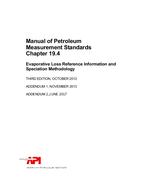
Product Details
- Published:
- 11/01/1997
- Number of Pages:
- 35
- File Size:
- 1 file , 250 KB
- Product Code(s):
- H19041, H19041
- Note:
- This product is unavailable in Cuba, Iran, North Korea, Syria
Recommended Practice for Speciation of Evaporative Losses
Handbook / Manual / Guide by American Petroleum Institute, 11/01/1997


Click here to purchase
Contains recommended methods for estimating specific organic compound emissions from storage tanks, and marine vessel transfer operations handling multi-componet hydrocarbon mixtures (such as crude oil and gasoline) associated with petroleum operations.

Click here to purchase
This standard provides methodology to estimate emissions of individual hydrocarbon species using the total emissions of multicomponent hydrocarbon mixtures (such as crude oils and gasoline) estimated from API MPMS Ch. 19.1 for fixed-roof tanks, API MPMS Ch. 19.2 for floating-roof tanks, API MPMS Ch. 19.5 for marine vessels, and other methods used for total hydrocarbon emission estimates. This process is referred to as speciation.
Speciation of emissions from hydrocarbon mixtures accounts for the higher evaporation rate of the more volatile components, resulting in a different composition of the mixture in the vapor phase than in the liquid phase. The methodology presented in this standard assumes that there is sufficient liquid present such that the chemical composition at the liquid surface may be considered to not change as a result of the evaporative loss.
This standard also contains reference information used for estimating emissions in accordance with API MPMS Ch. 19.1, API MPMS Ch.19.2, and API MPMS Ch.19.5.
The methodology in this standard applies to:
a)liquids with vapor pressure that has reached equilibrium with ambient conditions at a true vapor pressure less than the ambient atmospheric pressure (i.e. not boiling);
b)liquids for which the vapor pressure is known or for which sufficient data are available to determine the vapor pressure;
c)liquid mixtures where Raoult’s Law can be used to describe the vapor phase equilibria.
This methodology does not apply to:
d)emissions that result from leaks from piping components (e.g. valves, flanges, pumps, connectors etc.);
e)liquid mixtures where Raoult’s Law cannot be used to describe the vapor phase equilibria (e.g. mixtures in which hydrocarbons are dissolved in water, or mixtures of hydrocarbons with alcohols).